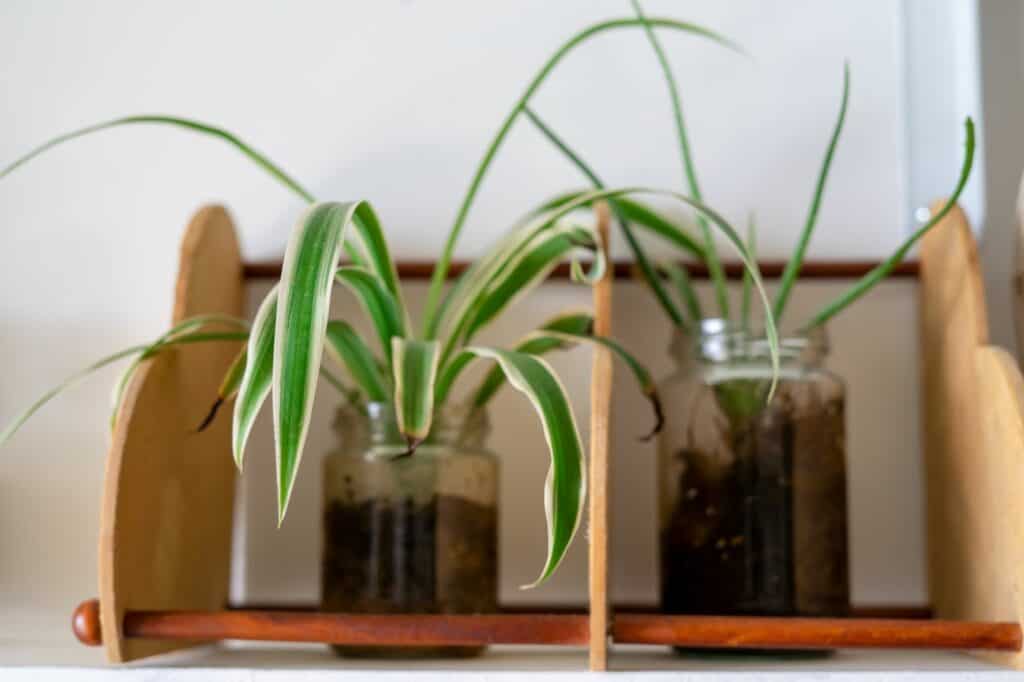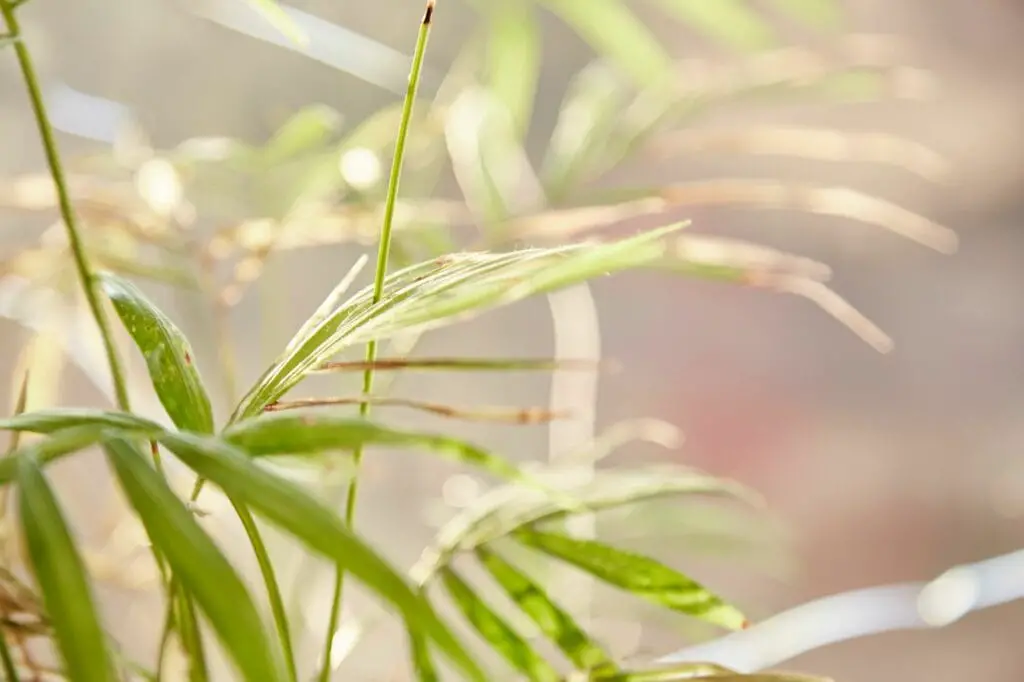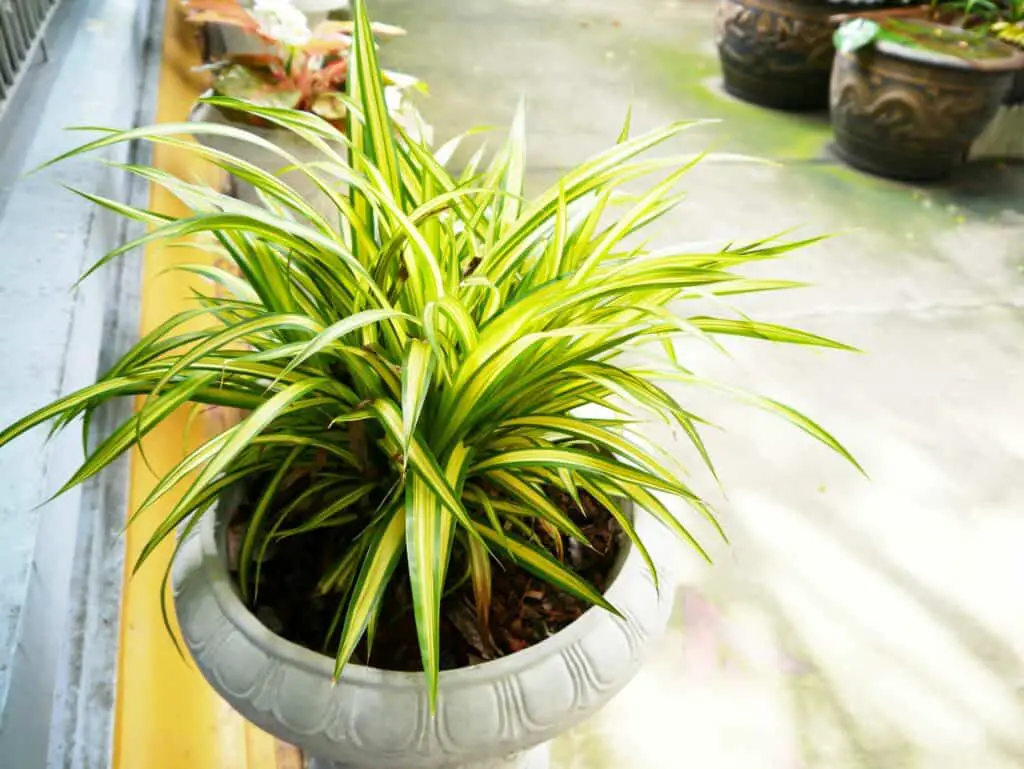Spider plants are a popular houseplant choice for many people. They are easy to care for, and their long, thin leaves make them an attractive addition to any room.
However, as with any plant, it’s important to make sure you are giving your spider plant the right amount of water. Underwatering is a common problem that can affect the health of your spider plant.
When a spider plant is underwatered, it can look quite different from an overwatered plant. One of the most obvious signs of underwatering is dry, brittle leaves.
The leaves may curl inwards towards the stem, and they may also turn yellow or brown and fall off easily. Wilting leaves are another sign that your spider plant is thirsty.
If you want to keep your spider plant healthy and thriving, it’s important to understand the signs of underwatering and how to prevent it.
In this article, we’ll take a closer look at what an underwatered spider plant looks like, the causes of underwatering, and how to revive an underwatered plant. We’ll also explore some tips for preventing underwatering in the first place, as well as common pests and diseases that can affect your spider plant.
Key Takeaways
- Underwatering can cause dry, brittle leaves, wilting, and yellowing or browning of leaves.
- Causes of underwatering include infrequent watering, using the wrong type of soil, and environmental factors such as low humidity.
- To revive an underwatered spider plant, water it thoroughly and make sure it is getting enough light. Prevent underwatering by watering regularly, using well-draining soil, and monitoring humidity levels.
Other related posts:
Overwatered Spider Plant (6 Signs and Solutions)
How to Revive a Dying Spider Plant: 4 Essential Tips

Understanding Spider Plants
Spider plants (Chlorophytum comosum) are a popular houseplant, known for their ease of care and ability to thrive in a variety of indoor environments.
They are native to South Africa and are a member of the lily family. Spider plants are characterized by their long, thin leaves that grow in a rosette pattern and arch gracefully outward. They are often grown in hanging baskets, which allows their foliage to cascade down in an attractive display.
One of the reasons spider plants are so popular is that they are easy to grow. They are tolerant of a wide range of light levels and can be grown in a variety of soil types.
They are also resistant to many common pests and diseases that can afflict indoor plants. However, like all plants, spider plants do have some specific care requirements that must be met in order for them to thrive.
One of the most important aspects of caring for a spider plant is ensuring that it receives the right amount of water. Overwatering and underwatering can both cause problems for spider plants.
Underwatered spider plants may have leaves that are dry, brown, and crispy. The leaves may also curl and become brittle. In severe cases, the plant may begin to wilt and the leaves may fall off.
To prevent underwatering, it is important to water spider plants regularly. The frequency of watering will depend on a variety of factors, including the size of the plant, the type of soil it is planted in, and the humidity of the surrounding environment.
As a general rule, spider plants should be watered when the top inch of soil feels dry to the touch. When watering, it is important to water the soil directly rather than the leaves, as wet leaves can lead to fungal diseases.

What Does an Underwatered Spider Plant Look Like
An underwatered spider plant is a plant that is not receiving enough water to thrive. This can cause a variety of symptoms that are easy to spot. Here are some signs that your spider plant is underwatered:
Wilting Leaves
One of the most obvious signs of an underwatered spider plant is wilting leaves. The leaves will appear limp and may even shrivel up. They will also feel dry to the touch. If you notice your spider plant’s leaves are wilting, it is a good indication that it needs more water.
Yellow or Pale Leaves
Another sign of an underwatered spider plant is yellow or pale leaves. When a spider plant is not receiving enough water, the leaves will turn yellow or pale. This is because the plant is not able to produce enough chlorophyll, which is necessary for photosynthesis.
Stunted Growth
An underwatered spider plant may also experience stunted growth. This is because the plant is not receiving enough water to support its growth. If you notice that your spider plant is not growing as quickly as it should be, it may be a sign that it needs more water.
Brown Spots or Brown Leaf Tips
Brown spots or brown leaf tips are another sign of an underwatered spider plant. When a spider plant is not receiving enough water, the leaves will start to dry out and turn brown. This can happen on the tips of the leaves or in spots throughout the plant.
Dry or Shriveled Appearance
An underwatered spider plant may also have a dry or shriveled appearance. This is because the plant is not receiving enough water to keep its leaves and stems hydrated. If you notice that your spider plant looks dry or shriveled, it may be a sign that it needs more water.

Causes of Underwatering
Underwatered spider plants can experience a range of symptoms, including dried-out leaves, wilting, yellow or brown discolouration, and leaf loss. Causes of underwatering can include poor drainage, lack of humidity, ignoring signs of thirst, and an inadequate watering schedule.
Watering
Watering is a crucial aspect of keeping spider plants healthy. If a spider plant is not watered enough, it can become underwatered. Spider plants need water to grow and thrive. However, overwatering can also be a problem, as it can lead to root rot.
Soil
The type of soil a spider plant is grown in can also affect whether it becomes underwatered. Spider plants prefer well-draining soil, which allows water to move through the soil quickly. If the soil is too dense, it can retain too much water, leading to root rot. Dry soil can also be a sign that a spider plant is underwatered.
Watering Frequency
The frequency with which a spider plant is watered can also contribute to whether it becomes underwatered. Spider plants require regular watering, but not too much. Overwatering can lead to root rot, while underwatering can cause the plant to become dehydrated.
Soil Drainage
Soil drainage is also an important factor in preventing underwatering. Spider plants need soil that drains well, allowing water to move through the soil quickly. If the soil does not drain well, water can accumulate in the soil, leading to root rot.
Pot Size and Container
The size of the pot and container can also affect whether a spider plant becomes underwatered. If the pot is too small, the soil can dry out quickly, leading to underwatering. A container that is too large can also cause problems, as it can retain too much water.
Location and Lighting Conditions
The location and lighting conditions of a spider plant can also affect whether it becomes underwatered. Spider plants prefer indirect light and moderate humidity. Direct sunlight can cause the leaves to become scorched, while low light can cause the plant to become dehydrated.
Weather and Temperature
The weather and temperature can also contribute to whether a spider plant becomes underwatered. Hot, dry weather can cause the soil to dry out quickly, leading to underwatering. Cold weather can also be a problem, as it can cause the plant to become dehydrated.
Humidity
Humidity is an important factor in preventing underwatering. Spider plants prefer moderate humidity and can become dehydrated if the air is too dry. Adding a humidifier or placing a tray of water near the plant can help to increase the humidity around the plant.
Impact on Spider Plant Health
Underwatering can have a significant impact on the health of a spider plant. Spider plants are hardy and can tolerate a certain amount of neglect, but they still require adequate watering to thrive. When a spider plant is underwatered, it can experience a range of symptoms that can negatively affect its overall health.
Root Health
The roots of a spider plant are critical to its health. When a spider plant is underwatered, the roots can become dry and brittle, making it difficult for the plant to absorb nutrients and water from the soil. Over time, this can cause the roots to die back, which can lead to stunted growth and a weakened plant.
Slow Growth
One of the most common symptoms of an underwatered spider plant is slow growth. When a spider plant is not receiving enough water, it will slow down its growth to conserve resources. This can result in a smaller plant with fewer leaves and a less vibrant appearance.
Brown Spots on Leaves
Another symptom of an underwatered spider plant is brown spots on the leaves. When a spider plant is not receiving enough water, the leaves can become dry and brittle, which can cause them to develop brown spots. In severe cases, the leaves can become yellow and fall off the plant.
Fungal Diseases
Underwatered spider plants are also more susceptible to fungal diseases. When the soil is too dry, it can create an environment where fungi can thrive. Fungal diseases can cause the leaves to turn brown or yellow, and can also create a foul smell around the plant.
To prevent these symptoms, it is important to water your spider plant regularly and ensure that the soil is moist but not waterlogged.
If you do notice any of these symptoms, you may need to repot your spider plant and provide it with fresh soil and adequate water. With proper care, a spider plant can recover from underwatering and continue to thrive.
Reviving an Underwatered Spider Plant
When a spider plant is underwatered, it may start to wilt and its leaves may turn brown or yellow. To revive an underwatered spider plant, it is important to provide it with adequate water and moisture.
The first step is to thoroughly soak the soil until water drains out, being careful not to overwater. This will help to rehydrate the plant and provide it with the moisture it needs. It is important to use the right kind of water when watering your spider plant. It is recommended to use distilled or filtered water as tap water may contain chemicals that can harm the plant.
After watering, it is important to ensure that the plant is getting enough oxygen. Aeration can be improved by loosening the soil around the roots with a fork or by gently shaking the plant. This will allow air to circulate around the roots, promoting healthy growth.
In addition to watering and aeration, it may be helpful to mist the leaves of the spider plant with water. This will help to increase humidity levels and prevent the leaves from drying out.
If the spider plant is still struggling after being watered, it may be necessary to repot the plant. Repotting can help to provide the plant with fresh soil and improve drainage. When repotting, it is important to trim any dead or damaged roots and to use a well-draining soil mix.
Finally, it is important to fertilize the spider plant regularly to promote healthy growth. Liquid fertilizer can be added to the water when watering the plant, or a slow-release fertilizer can be added to the soil. It is important to follow the instructions on the fertilizer package and not to over-fertilize the plant.

Preventing Underwatering
Underwatering is a common problem with spider plants that can lead to dried out leaves, wilting, yellow or brown discolouration, and leaf loss. Here are some tips to prevent underwatering and keep your spider plant healthy:
Watering
Water your spider plant thoroughly when the top inch of soil is dry to the touch. This will ensure that the roots are getting enough moisture without overwatering. Use room temperature water and avoid using water that has been treated with a water softener or contains high levels of chlorine.
Care
Spider plants are relatively low-maintenance plants and do not require frequent fertilization or pruning. However, regular care such as dusting the leaves, removing dead or yellow leaves, and checking for pests can help prevent stress and keep the plant healthy.
Soil and Potting Mix
Use a well-draining potting mix that is specifically formulated for indoor plants. Avoid using heavy garden soil or soil that contains a lot of clay, as this can lead to poor drainage and waterlogging. Adding perlite or sand to the potting mix can improve drainage and prevent water from accumulating in the bottom of the pot.
Drainage Holes
Make sure that your spider plant pot has drainage holes to allow excess water to escape. If your pot does not have drainage holes, you can drill them yourself or use a cachepot (decorative outer pot) with drainage holes and a saucer to catch excess water.
Light
Spider plants prefer bright, indirect light but can tolerate lower light conditions. Avoid placing your spider plant in direct sunlight, as this can cause the leaves to burn and dry out.
Humidity and Temperature
Spider plants prefer moderate to high humidity levels and temperatures between 18-27°C (65-80°F).
If the air in your home is dry, you can increase humidity by placing a tray of water near the plant or using a humidifier. Avoid placing your spider plant in drafty areas or near heating or cooling vents.
Location and Pot Size
Choose a location for your spider plant that is away from cold drafts, direct sunlight, and heating or cooling vents. Spider plants prefer to be slightly pot-bound, so choose a pot that is only slightly larger than the root ball. Repotting too frequently can lead to overwatering and root rot.
Watering Frequency
The frequency of watering your spider plant will depend on a variety of factors, such as the size of the pot, the amount of light and humidity, and the temperature.
In general, you should water your spider plant once a week during the growing season and reduce watering in the winter months when growth slows down. However, always check the soil moisture level before watering to avoid overwatering or underwatering.
Common Pests and Diseases
Spider plants are generally hardy and low-maintenance houseplants. However, they can still be affected by pests and diseases. Here are some common issues to look out for:
Pests
Spider mites, aphids, and whiteflies are the most common pests that can infest spider plants. These pests feed on the plant’s sap, causing damage to the leaves and stunted growth.
Mealybugs are another common pest that can infest spider plants. They are small, white, and fuzzy insects that can be found on the undersides of leaves and in leaf axils. They also feed on the plant’s sap and can cause yellowing and wilting of the leaves.
To prevent pest infestations, regularly inspect your spider plant for any signs of pests. You can also use insecticidal soap or neem oil to control pest populations.
Diseases
Spider plants can also be affected by fungal diseases, such as leaf spot and root rot. Leaf spot appears as dark spots on the leaves, and root rot causes the plant’s roots to rot and turn brown.
To prevent fungal diseases, avoid overwatering your spider plant and make sure it has good drainage. If you notice any signs of fungal disease, remove the affected leaves and adjust your watering schedule accordingly.
Mold can also be a problem for spider plants, especially if they are grown in humid environments. To prevent mold, make sure your spider plant has good airflow and is not overcrowded with other plants.

Propagation of Spider Plants
Spider plants are easy to propagate and make great gifts for friends and family. Propagation can be done in several ways, including water propagation and soil propagation.
Propagation can be done at any time of the year, but it is best to do it during the spring or the growing season. During this time, the plant will be actively growing and will be better able to handle the stress of propagation.
To propagate spider plants, the first step is to identify the plantlets. These are small, offshoots that grow from the main plant. Once the plantlets have developed roots of their own, they can be separated from the parent plant.
To propagate using water, the plantlet should be placed in a container of water. The container should be kept in a bright, warm location, but out of direct sunlight. The water should be changed every few days to prevent stagnation and the formation of algae.
To propagate using soil, the plantlet should be planted in a small pot filled with well-draining soil. The soil should be kept moist, but not waterlogged. The pot should be placed in a bright, warm location, but out of direct sunlight.
Spider plants can also be propagated using cuttings. To do this, cut a healthy stem from the parent plant and place it in water or soil. Keep the cutting in a bright, warm location and wait for roots to develop before transplanting to a larger pot.
Conclusion
To maintain a healthy spider plant, it is important to water it correctly. An underwatered spider plant will show signs of dehydration, such as wilting, browning, and yellowing of the leaves. The soil will feel dry to the touch, and the top inch of the soil surface will be visibly dry.
To revive an underwatered spider plant, it is important to water it thoroughly until water drains out of the bottom of the container.
It is important not to overwater the plant, as this can lead to root rot and other common issues. The best way to water a spider plant is to water it deeply and then allow the soil to dry out before watering again.
In addition to proper watering, it is important to provide spider plants with bright, indirect light and a well-draining potting mix.
Spider plants are hardy and adaptable, and they can tolerate a range of climates and conditions. However, they prefer warm, humid environments and may struggle in dry or arid climates.
Common issues with spider plants include overwatering, underwatering, and pests such as spider mites and mealybugs. To prevent these issues, it is important to maintain a consistent watering schedule and to keep the plant clean and free of debris.
Frequently Asked Questions
How can you tell if a spider plant is being underwatered?
Underwatered spider plants will have droopy leaves that may curl inward. The leaves may also turn yellow and brown, and the tips of the leaves may become dry and crispy. The soil may also be dry to the touch.
What are the symptoms of an underwatered spider plant?
The symptoms of an underwatered spider plant include droopy and curled leaves, yellow and brown leaves, dry and crispy leaf tips, and dry soil. The plant may also stop producing new leaves and runners.
What should you do if your spider plant is underwatered?
If your spider plant is underwatered, you should water it thoroughly until the water drains out of the bottom of the pot. You should also mist the leaves to increase humidity. Make sure to water the plant regularly to prevent it from becoming underwatered again.
Can spider plants recover from being underwatered?
Yes, spider plants can recover from being underwatered if they are watered properly and given enough time to recover. However, if the plant has been severely underwatered for a long time, it may not recover.
What are the signs of an overwatered spider plant?
Overwatered spider plants may have yellow and soft mushy leaves, as well as soft and mushy roots. The soil may also be wet, soggy, and moldy. The leaves may be puffy and soft, and may have brown spots. The plant may also wilt and drop leaves, and may have a shriveled and mushy appearance.
How often should you water a spider plant?
Spider plants should be watered once a week during the growing season, and once every two weeks during the winter. However, the frequency of watering may vary depending on the humidity, temperature, and light conditions in your home. It is important to check the soil moisture level before watering to prevent overwatering or underwatering.

Hey, I’m Lisa and I’ve been an avid gardener for over 30 years. I love writing, talking and living in the garden! Feel free to connect with me on my socials below


